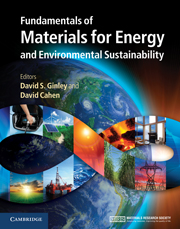Book contents
- Frontmatter
- Contents
- Contributors
- Preface
- Acknowledgments
- Part 1 Energy and the environment: the global landscape
- Part 2 Nonrenewable energy sources
- Part 3 Renewable energy sources
- Part 4 Transportation
- Part 5 Energy efficiency
- Part 6 Energy storage, high-penetration renewables, and grid stabilization
- 42 Toward the smart grid: the US as a case study
- 43 Consequences of high-penetration renewables
- 44 Electrochemical energy storage: batteries and capacitors
- 45 Mechanical energy storage: pumped hydro, CAES, flywheels
- 46 Fuel cells
- 47 Solar fuels
- 48 Solar thermal routes to fuel
- 49 Photoelectrochemistry and hybrid solar conversion
- Summary
- Appendix A Thermodynamics
- Appendix B Electrochemistry
- Appendix C Units
- Index
- References
46 - Fuel cells
from Part 6 - Energy storage, high-penetration renewables, and grid stabilization
Published online by Cambridge University Press: 05 June 2012
- Frontmatter
- Contents
- Contributors
- Preface
- Acknowledgments
- Part 1 Energy and the environment: the global landscape
- Part 2 Nonrenewable energy sources
- Part 3 Renewable energy sources
- Part 4 Transportation
- Part 5 Energy efficiency
- Part 6 Energy storage, high-penetration renewables, and grid stabilization
- 42 Toward the smart grid: the US as a case study
- 43 Consequences of high-penetration renewables
- 44 Electrochemical energy storage: batteries and capacitors
- 45 Mechanical energy storage: pumped hydro, CAES, flywheels
- 46 Fuel cells
- 47 Solar fuels
- 48 Solar thermal routes to fuel
- 49 Photoelectrochemistry and hybrid solar conversion
- Summary
- Appendix A Thermodynamics
- Appendix B Electrochemistry
- Appendix C Units
- Index
- References
Summary
Focus
Over the last two decades the problem of limited oil and gas supply versus new emerging-nation demands has created an immediate need for new technologies to alleviate global dependence on a hydrocarbon-based energy policy. This requires significant changes in the way global energy-system policy is managed and the rapid adoption/introduction of an array of new technologies that produce and use energy more efficiently and more cleanly than in the past. Specifically, these energy policy changes have directly led to more focus on commercial applications of alternative, sustainable energy policy. This chapter is centered on the establishment of a hydrogen-based economy, specifically as it relates to fuel cells. The net result is the concept of hydrogen and fuel cells as a practical foundation for implementing public policies responding to growing uncertainties about the security and long-term price of oil and environmental concerns. With the expectation that fuel cells and hydrogen can play a significant role in the global energy economy, governments are committing funds for research, development, and demonstration of hydrogen and fuel cells as they strive to create programs for viable infrastructure to support their use.
Synopsis
Fuel cells generate energy from controlled, spontaneous oxidation–reduction (redox) reactions. A fuel cell is a multi-component device with two electrodes, separated by an ionic conductive membrane, the positive anode where the oxidation reaction (loss of electrons LEO) occurs and the negative cathode where the reduction reaction (gain of electrons GER) occurs (LEO goes GER, lose electrons oxidation, gain electrons reduction). As with battery systems, there are several kinds of fuel cells, and each operates a bit differently, but in general the fuel cell uses hydrogen (or hydrogen-rich fuel) at the anode and oxygen (air) at the cathode, to create electricity. As mentioned, the typical fuel cell consists of two electrodes: the negative electrode (or anode) and a positive electrode (or cathode), separated by an ion (charge)-conducting electrolyte. In a model system, the hydrogen is fed to the anode, and oxygen is fed to the cathode. Through the utilization of the catalyst, the activation energy barrier for the separation of hydrogen atoms into protons (H+) and electrons (e−) is decreased substantially, making it kinetically viable at <80 °C, i.e., the catalyst lowers the activation barrier for the chemical reactions and increases the rate at which the reactions occur. The electrons generated are forced to go through an external circuit, which creates creating a flow of electrons (electricity). In order to complete the balance of charge required in redox reactions, the protons migrate through the electrolyte to the cathode, where they react with oxygen and the electrons to produce water and heat. So, as long as fuel (hydrogen) and air are supplied, the fuel cell will generate electricity. A single fuel cell generates a small amount of electricity so, in practice, similarly to what is done every day with loading multiple batteries to operate an electronic device, fuel cells are usually assembled into a stack of multiple cells to meet the specific power and energy requirements of the particular application.
- Type
- Chapter
- Information
- Publisher: Cambridge University PressPrint publication year: 2011
References
- 2
- Cited by



